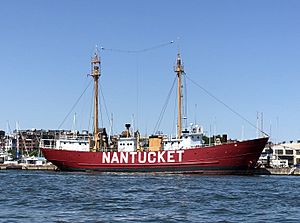United States lightship Nantucket (LV-112) facts for kids

Nantucket docked in Boston Harbor in 2018.
|
|
| History | |
|---|---|
| Operator |
|
| Builder | Pusey and Jones |
| Cost | $300,956 |
| Yard number | 431 |
| Laid down | 17 July 1935 |
| Launched | 21 March 1936 |
| Completed | 9 May 1936 (delivery) |
| In service | 1936 |
| Out of service | 1983 |
| Honors and awards |
Declared National Historic Landmark in 1989 |
| Status | Museum ship |
| General characteristics | |
| Type | Lightvessel |
| Displacement | 1,050 tons |
| Length |
|
| Beam | 32 ft (9.8 m) |
| Draft | 16 ft 3 in (4.95 m) |
| Propulsion |
|
| Speed | 12 knots (22 km/h; 14 mph) |
| Armament | 1 3-inch (76 mm) gun (1942–1945) |
|
Lightship No. 112, Nantucket
|
|
| Location | East Boston, Massachusetts |
| Built | 1936 |
| Architect | Pusey and Jones |
| NRHP reference No. | 89002464 |
| Significant dates | |
| Added to NRHP | 20 December 1989 |
| Designated NHL | 20 December 1989 |
The Nantucket (LV-112) is a special kind of ship called a lightship. It's so important that it's been named a National Historic Landmark. This ship helped guide other vessels at the Lightship Nantucket station.
It was the very last lightship to be used in the United States. When it was named a landmark, it was one of only two lightships that could still move on their own. The Nantucket helped guide famous ships like the United States, Queen Mary, and Normandie.
The ship was officially called Light Vessel No. 112, or LV-112. This was a permanent name for the ship. Lightships often had the name of their station painted on them. LV-112 was built to replace another lightship, LV-117, which had sunk. It was designed with special safety features. It was also the largest lightship ever built!
The Nantucket mostly stayed at the Nantucket station. But during World War II (1942-1945) and from 1958-1960, it worked as a relief ship. This meant it filled in for other lightships at different stations.
Contents
A Ship's Important Job: Government Service
Why a New Lightship Was Needed
Another lightship, Light Vessel 117, was working at the Nantucket station. On May 15, 1934, a large ship called the Olympic crashed into it. The Olympic was a sister ship to the famous Titanic. Seven of the eleven crew members on LV-117 were lost.
The British government paid for the new lightship, LV-112. It cost $300,956, which was a lot of money back then! This new ship was built to be very strong and last a long time. It did, serving until 1983.
How the Nantucket Was Built
The building of the Nantucket started on July 17, 1935. It was built by the Pusey and Jones company in Delaware. The ship was launched into the water on March 21, 1936. It was ready for service by May 9, 1936.
The ship was made of steel and designed to be very safe. Its hull had many separate sections. This design helped keep the ship afloat even if some parts were damaged. The ship was about 148 feet (45 meters) long. It was 32 feet (9.7 meters) wide and sat 16 feet (4.9 meters) deep in the water. It weighed 1,050 tons.
When it was first built, the Nantucket used two oil-fired boilers. These created steam for its engine, which gave it a top speed of 12 knots (about 14 miles per hour). In 1960, the steam engine was replaced with a more modern 900 horsepower diesel engine.
Lights and Sounds: How the Ship Signaled
The Nantucket had special equipment to help guide ships.
- It had a bright electric lantern on each of its two masts.
- For foggy weather, it had a loud two-tone air horn called a diaphone. This horn was synced with a radio beacon.
- It also had an underwater sound signal (removed in 1939) and a hand-operated bell.
- To stay in the right place, the ship had a radio direction finder.
- In 1943, radar was added, which helped it detect other ships and objects.
- In 1960, the lights were updated. The front mast got a new lens. The main mast got a revolving lamp with six powerful locomotive headlights on each side.
Working at Sea: Ship Operations
The Nantucket was stationed at Nantucket Shoals from 1936 to 1942. During World War II, the ship was taken off its station. It was armed with a 3-inch gun. It then served as an "examination vessel" near Portland, Maine. This meant it helped check ships entering the harbor. It returned to its Nantucket station in 1945.
In 1958, another lightship, WLV-196, took its place at Nantucket. The Nantucket (LV-112) then became a relief vessel for the 1st District. It served at many different stations during this time. These included Boston, Pollock Rip Shoal, Stonehorse, Cross Rip, Buzzards Bay, and Brenton Reef.
In April 1960, the ship went through a big upgrade. It was modernized at the Coast Guard's Curtis Bay Yard. After this, LV-112 was sent back to Nantucket Shoals. It stayed there until 1975.
Life After Service: Retirement
On March 21, 1975, the Nantucket (LV-112) left its station for good. It was replaced by WLV-612. On March 28, 1975, it was officially taken out of service. It was then stored in Chelsea, Massachusetts.
From December 6-7, a group of volunteers from Nantucket sailed the ship to Nantucket Island. It was used there as a museum ship until 1984. In 1986, a group called Nantucket Lightship Preservation, Inc. bought the ship. They wanted to restore and preserve it.
New Owners: Private Ownership
In 1989, the Nantucket was declared a National Historic Landmark. At that time, the ship was in South Portland, Maine. It also traveled along the New England Coast. For a while, there were plans to keep it permanently in Staten Island, New York. However, it spent several years in Oyster Bay (hamlet), New York.
In October 2009, the United States Lightship Museum (USLM) bought the ship for just $1. On May 11, 2010, it arrived in Boston Harbor. The museum plans to restore the ship. This will cost about $1 million. Today, the Nantucket is being renovated as a floating museum. You can visit it at the Boston Harbor Shipyard and Marina in East Boston, Massachusetts.


